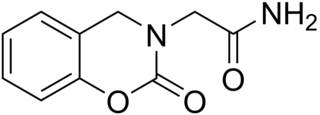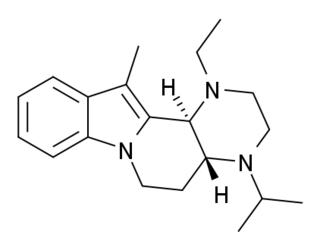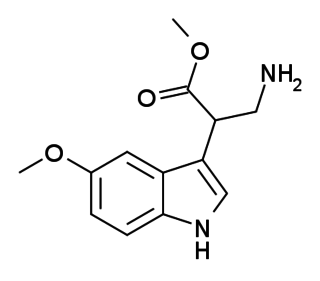
Moxonidine (INN) is a new-generation alpha-2/imidazoline receptor agonist antihypertensive drug licensed for the treatment of mild to moderate essential hypertension. It may have a role when thiazides, beta-blockers, ACE inhibitors, and calcium channel blockers are not appropriate or have failed to control blood pressure. In addition, it demonstrates favourable effects on parameters of the insulin resistance syndrome, apparently independent of blood pressure reduction. It is manufactured by Solvay Pharmaceuticals under the brand name Physiotens.

Camazepam is a benzodiazepine psychoactive drug, marketed under the brand names Albego, Limpidon and Paxor. It is the dimethyl carbamate ester of temazepam, a metabolite of diazepam. While it possesses anxiolytic, anticonvulsant, skeletal muscle relaxant and hypnotic properties it differs from other benzodiazepines in that its anxiolytic properties are particularly prominent but has comparatively limited anticonvulsant, hypnotic and skeletal muscle relaxant properties.

Doxefazepam is a benzodiazepine medication It possesses anxiolytic, anticonvulsant, sedative and skeletal muscle relaxant properties. It is used therapeutically as a hypnotic. According to Babbini and colleagues in 1975, this derivative of flurazepam was between 2 and 4 times more potent than the latter while at the same time being half as toxic in laboratory animals.

Econazole is an antifungal medication of the imidazole class. It is sold under the brand names Spectrazole and Ecostatin (Canada), among others. It is a component of Pevisone and Ecoderm-TA (econazole/triamcinolone).
The alpha-2 (α2) adrenergic receptor is a G protein-coupled receptor (GPCR) associated with the Gi heterotrimeric G-protein. It consists of three highly homologous subtypes, including α2A-, α2B-, and α2C-adrenergic. Some species other than humans express a fourth α2D-adrenergic receptor as well. Catecholamines like norepinephrine (noradrenaline) and epinephrine (adrenaline) signal through the α2-adrenergic receptor in the central and peripheral nervous systems.

Niaprazine (INN) is a sedative-hypnotic drug of the phenylpiperazine group. It has been used in the treatment of sleep disturbances since the early 1970s in several European countries including France, Italy, and Luxembourg. It is commonly used with children and adolescents on account of its favorable safety and tolerability profile and lack of abuse potential.

Zipeprol is a centrally acting cough suppressant developed in France in the 1970s. It is not a morphinan derivative. Zipeprol acts as a local anaesthetic and has mucolytic, antihistamine and anticholinergic properties. It is sold with several brand names such as Zinolta and Respilene. It is not available in the United States or Canada and has been discontinued in Europe. It is still available in some countries in Asia and South America.
Imidazoline receptors are the primary receptors on which clonidine and other imidazolines act. There are three main classes of imidazoline receptor: I1 is involved in inhibition of the sympathetic nervous system to lower blood pressure, I2 has as yet uncertain functions but is implicated in several psychiatric conditions, and I3 regulates insulin secretion.

Arylcyclohexylamines, also known as arylcyclohexamines or arylcyclohexanamines, are a chemical class of pharmaceutical, designer, and experimental drugs.

Caroxazone is an antidepressant which was formerly used for the treatment of depression but is now no longer marketed. It acts as a reversible monoamine oxidase inhibitor (RIMA) of both MAO-A and MAO-B subtypes, with five-fold preference for the latter.

Atiprosin (AY-28,228) is an antihypertensive agent which acts as a selective α1-adrenergic receptor antagonist. It also possesses some antihistamine activity, though it is some 15-fold weaker in this regard than as an alpha blocker. It was never marketed.

Fostedil is a vasodilator acting as a calcium channel blocker which was under development for the treatment of heart conditions such as angina pectoris but was never marketed. It has antihypertensive and antiarrhythmic effects.

Tiamenidine is a imidazoline compound that shares many of the pharmacological properties of clonidine. It acts as a centrally-acting α1 and α2 adrenergic receptor antagonist. In hypertensive volunteers, like clonidine, it significantly increased sinus node recovery time and lowered cardiac output. It was marketed by Sanofi-Aventis under the brand name Sundralen for the management of essential hypertension.

Litracen (N-7,049) is a tricyclic antidepressant which was never marketed.

Lortalamine (LM-1404) is an antidepressant which was synthesized in the early 1980s. It acts as a potent and highly selective norepinephrine reuptake inhibitor. Lortalamine was under development for clinical use but was shelved, likely due to the finding that it produced ocular toxicity in animals. It has been used to label the norepinephrine transporter in positron emission tomography studies.

G-130 is a drug with stimulant and anorectic effects, related to phenmetrazine.

Indorenate (TR-3369), is a tryptamine derivative which acts as an agonist at the 5-HT1A, 5-HT1B and 5-HT2C serotonin receptors. It has anxiolytic, antihypertensive and anorectic effects, predominantly through action at 5-HT1A, but with some contribution from the 5-HT1B and 5-HT2C subtypes, and possibly some other non-serotonergic targets also.

Fluperlapine, also known as fluoroperlapine, is a morphanthridine (11H-dibenzo[b,e]azepine ) atypical antipsychotic with additional antidepressant and sedative effects. It was first synthesized in 1979, and then subsequently studied in animals and humans in 1984 and beyond, but despite demonstrating efficacy in the treatment of a variety of medical conditions including schizophrenia, psychosis associated with Parkinson's disease, depressive symptoms, and dystonia, it was never marketed. This was perhaps due to its capacity for producing potentially life-threatening agranulocytosis, similarly to clozapine, which it closely resembles both structurally and pharmacologically.

Valperinol is a drug which acts as a calcium channel blocker. It was patented as a possible sedative, antiepileptic, and/or antiparkinsonian agent, but was never marketed.

SL-164 is an analogue of methaqualone developed in the late 1960s by a team at Sumitomo. SL-164 has similar sedative, hypnotic and anticonvulsant properties to the parent compound, but was never marketed for clinical use.


















